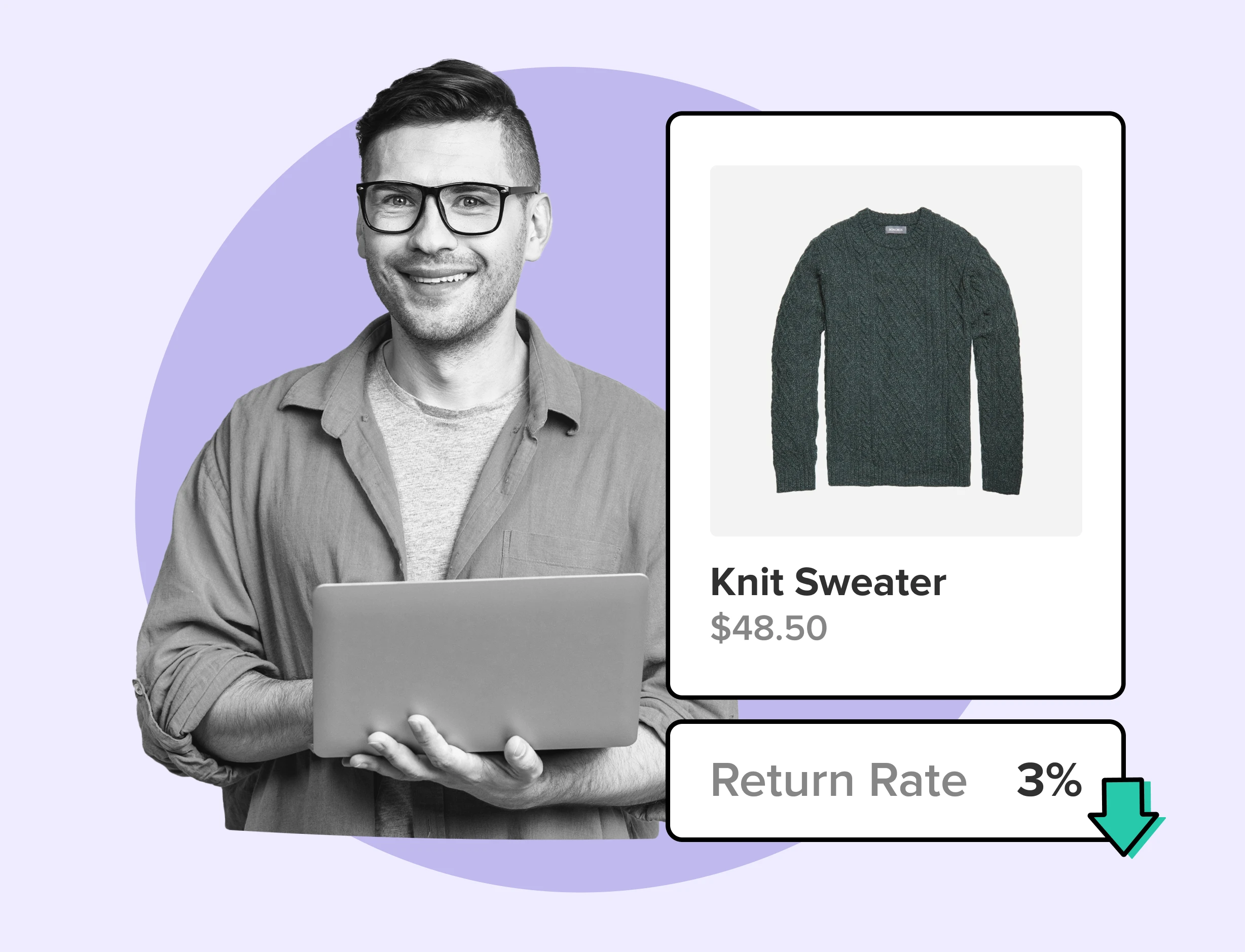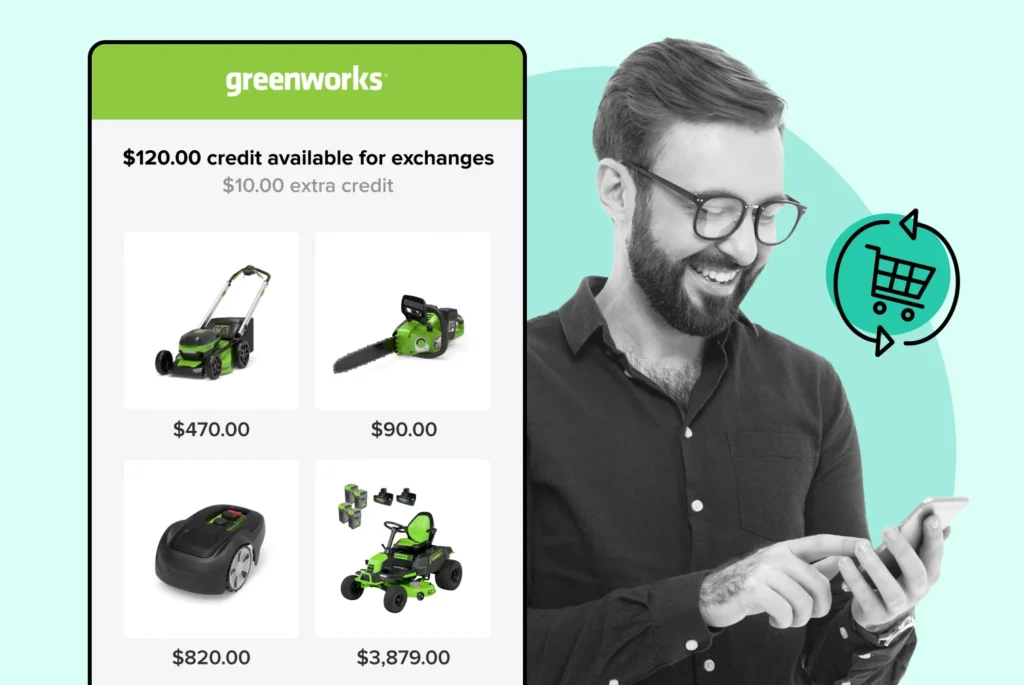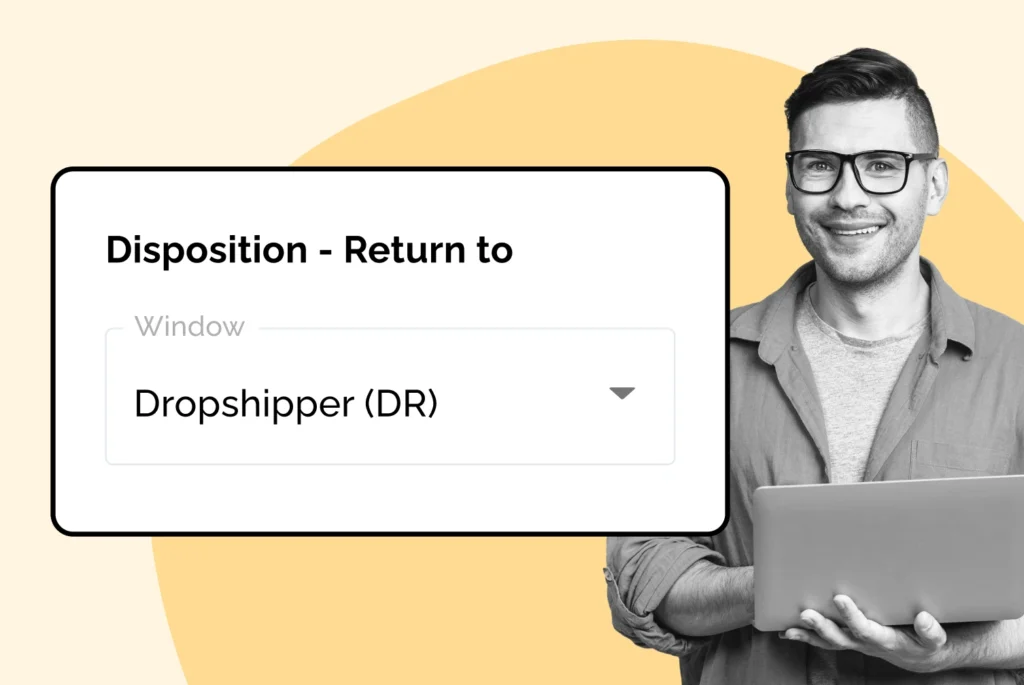
Top Ways to Enhance Product Descriptions with Returns Data
How to transform returns data into a powerful tool for refining your product descriptions and improving your bottom line!
Shipping, Tracking & Notifications
Boost customer experience and reduce support tickets
Realtime order and shipment tracking
Proactive order and shipping notifications
AI-Enhanced Discounted Labels
Predictive pre-purchase estimated delivery dates
Self-Serivce branded order tracking
Effortless experience delivered
Identify and Resolve Order Issues
Realtime order and shipment tracking
Make returns profitable and delight customers
Flexibility to define any return destinations & conditions
Simplify returns for your customers and team
Incentivize exchanges over returns
Returns management made easy for your team
Returns management made easy for your team
Easy claims and smart upsells
Understand why your customers are returning
In-Store & Curbside Pickup
Unify the online and the in-store experience
Hassle-free pickup experience for customers
In-Store dashboard to keep operations streamlined
In-Store and Online orders unified
Drive foot-traffic to your stores
Shipping, Tracking & Notifications
Boost customer experience and reduce support tickets
Realtime order and shipment tracking
Proactive order and shipping notifications
AI-Enhanced Discounted Labels
Predictive pre-purchase estimated delivery dates
Self-Serivce branded order tracking
Effortless experience delivered
Identify and Resolve Order Issues
Realtime order and shipment tracking
Make returns profitable and delight customers
Flexibility to define any return destinations & conditions
Simplify returns for your customers and team
Incentivize exchanges over returns
Returns management made easy for your team
Returns management made easy for your team
Understand why your customers are returning
In-Store & Curbside Pickup
Unify the online and the in-store experience
Hassle-free pickup experience for customers
In-Store Dashboard to keep operations streamlined
In-Store and Online orders unified
Drive foot-traffic to your stores
Boost customer experience and reduce support tickets
Realtime order and shipment tracking
Proactive order and shipping notifications
AI-Enhanced Discounted Labels
Predictive pre-purchase estimated delivery dates
Self-Serivce branded order tracking
Effortless experience delivered
Make returns profitable and delight customers
Flexibility to define any return destinations & conditions
Simplify returns for your customers and team
Incentivize exchanges over returns
Returns management made easy for your team
Equip your team for precise return checks.
Easy claims and smart upsells
Understand why your customers are returning
Unify the online and the in-store experience
Hassle-free pickup experience for customers
In-Store Dashboard to keep operations streamlined
In-Store and Online orders unified
Drive foot-traffic to your stores
Find the answer to all your questions
Take a step by step trip through our functionality to see how we can improve your ecommerce processes.
Explore the most comon questions about WeSupply
Calculate the ROI that WeSupply can bring you
Read actionable articles on how to optimize your post-purchase experience and decrease support tickets
Get inspired by stories of how our customers implemented an effortless post-purchase experience
Wondering if WeSupply is a good fit for you? Read through our use cases to see how we can help you increase conversion & improve CX!
A Deep Dive into Top Companies' Order Tracking & Returns Strategy
Find the answer to all your questions
Explore the most comon questions about WeSupply
Calculate the ROI that WeSupply can bring you
Request a no strings attached review of your current shopping experience and missed conversion opportunities
Take a step by step trip through our functionality to see how we can improve your ecommerce processes.
Read actionable articles on how to optimize your post-purchase experience and decrease support tickets
Get inspired by stories of how our customers implemented an effortless post-purchase experience
A Deep Dive into Top Companies' Order Tracking & Returns Strategy
Wondering if WeSupply is a good fit for you? Read through our use cases to see how we can help you increase conversion & improve CX!

Want to cut down on product returns that hurt your bottom line? The Pareto Principle, or 80/20 rule, can help. By focusing on the 20% of issues causing 80% of your returns, you can implement targeted strategies for major improvements. This article will show you how to use data to spot these key problems and what steps to take to fix them, ultimately helping you to reduce product returns Pareto style.
Applying the Pareto Principle (80/20 rule) in ecommerce reveals that a small percentage of issues are responsible for the majority of product returns, allowing businesses to target these key areas for maximum efficiency.
Enhancing product quality control, improving product descriptions, targeting frequent returners, analyzing customer feedback, and clear communication are critical strategies to reduce return rates.
Balancing flexible and strict return policies, optimizing inventory management, and leveraging customer feedback can lead to lower reverse logistics costs, a better customer experience, improved stock availability, and reduced shipping damage.
WeSupply helps reduce eCommerce returns with advanced analytics and smart return rules, improving product offerings and optimizing return policies. It also enhances inventory management and tracks customer satisfaction for continuous improvement. Get started with WeSupply today for seamless return management.
For ecommerce businesses, the reduction of product returns is vital. In an industry where margins are often thin, the costs associated with returns can significantly impact a business’s bottom line. Moreover, frequent returns can erode customer trust and satisfaction, leading to lost sales and diminished customer loyalty.
Understanding specific customer behavior trends is necessary to develop effective solutions for certain customers. General solutions often fall short, as they fail to address the unique challenges each business faces. Creating targeted strategies to reduce returns and enhance customer satisfaction and loyalty becomes possible when businesses identify the root causes of returns and analyze customer complaints.
The 80/20 rule, also known as the Pareto Principle, suggests that 80% of outcomes result from 20% of causes. Named after the Italian economist Vilfredo Pareto, who observed that 80% of Italy’s wealth was owned by 20% of the population, this principle has been widely applied across various fields, including business and economics.
In the context of ecommerce, the Pareto Principle states that a small percentage of products or issues often account for the majority of returns. Significant improvements in productivity and profitability are possible when businesses prioritize their efforts and resources more effectively by identifying and focusing on these key factors.
A thorough analysis of product return data is the starting point for applying the Pareto Principle effectively. Pareto charts, which are graphical representations combining bar and line chart elements, are particularly useful in this regard. By using a line chart to display the cumulative impact, businesses can quickly identify the most significant causes of returns by plotting the frequency of different return reasons on the x-axis and their cumulative impact on the y-axis.
For example, a Pareto chart might reveal that 80% of returns are due to only 20% of the identified reasons. With this pareto chart example, businesses can use resources more efficiently and achieve more impactful solutions by prioritizing these key issues. This method of Pareto analysis not only highlights the primary areas for improvement but also provides a clear visual representation of where efforts should be focused through statistical analysis.
Reducing return rates necessitates addressing common issues leading to returns. These issues often include:
Product quality control
Inaccurate product descriptions
Targeting frequent returners
Analyzing customer feedback
Enhancing customer communication
Ensuring high product standards is a fundamental step in minimizing returns. Implementing stringent quality control measures can help achieve this goal. Here are some steps you can take:
Regularly inspect products to identify defects and damages before shipping them to customers.
Train your staff to recognize quality issues and take appropriate action.
Use quality control tools and techniques, such as statistical process control, to monitor and improve product quality.
Establish clear quality standards and communicate them to your suppliers and employees. By taking these steps, you can reduce the likelihood of returns due to quality issues and enhance overall customer satisfaction.
Frequent reports of damaged products may indicate insufficient packaging or unreliable shipping services. By improving packaging materials and choosing reliable shipping partners, businesses can significantly reduce the incidence of damaged goods, thereby decreasing return rates. Robust quality control measures are essential for maintaining high standards and minimizing returns.
Reducing returns extensively relies on accurate and detailed product descriptions. Here are some tips to help you create effective product descriptions:
Provide high-quality images from multiple angles.
Include detailed specifications, such as dimensions and materials information.
Use clear and concise language to describe the product’s features and benefits.
Highlight any unique selling points or special features.
Anticipate and address potential customer questions or concerns. By providing this level of transparency, customers will have a clear understanding of what they are purchasing, which reduces the likelihood of returns due to unmet expectations.
Interactive size guides and customer size-related reviews are particularly useful for apparel and footwear products. These tools help customers choose the correct size, minimizing returns due to incorrect fit. Verifying that product images provided by manufacturers match the actual items can also prevent disappointing customers, thereby reducing returns.
Return rates of a business can be significantly impacted by frequent returners. By analyzing customer return patterns, businesses can:
Identify customers with high return rates
Address the root causes through improved product descriptions and customer service
Segment frequent returners for targeted strategies to reduce return rates.
Additionally, AI can be utilized to monitor return patterns and identify potential wardrobing situations. Implementing measures to block habitual wardrobers from making future purchases can help prevent abuse of return policies, ensuring that the return system is not misused.
Improving customer satisfaction and reducing returns hinge on collecting and acting on customer feedback. Analyzing return reasons and patterns can provide actionable insights to improve product quality and inventory strategies. This feedback loop allows businesses to make necessary adjustments, thereby reducing future returns.
Using return data to optimize product descriptions and enhance product offerings can also significantly reduce return rates. Customer feedback can reveal recurring issues, allowing for targeted improvements that address the root causes of returns. This proactive approach not only improves customer satisfaction but also helps prevent potential chargeback problems.
Reducing returns is heavily reliant on clear and proactive communication with customers. Providing comprehensive return policies on the website ensures that customers understand the conditions and procedures for returns. This transparency helps manage customer expectations and reduces confusion.
Offering multiple communication channels, such as live chat and phone support, can address customer inquiries efficiently and prevent dissatisfaction. Proactive communication about shipping delays and timely updates on shipments can also optimize customer service and prevent disputes.
WeSupply helps eCommerce businesses tackle common issues leading to returns by providing comprehensive Returns Analytics. This tool allows you to understand why customers are returning products, identify the most returned items, and recognize serial returners. By leveraging actionable insights, businesses can reduce their return rates and improve product offerings at the SKU level, identifying reasons such as color, quality, and size. Additionally, with Logistics Analytics, businesses can measure and track their efforts to enhance the post-purchase customer experience, ensuring constant fine-tuning and adaptation to customer needs.
Key Features:
In 2020, as COVID-19 accelerated e-commerce growth, EVEREVE faced significant challenges with high return rates typical in the fashion industry, which often exceeded 30%. The manual and fragmented returns process at EVEREVE led to inefficiencies, lack of visibility, and overwhelmed customer service teams.
The Challenge:
High return rates and a manual, time-consuming process.
Limited visibility into returns, causing issues in identifying return reasons and managing merchandise.
Overburdened customer service due to return-related inquiries.
The Solution: EVEREVE transformed its returns process with WeSupply’s Magento & Custom API integrations, automating returns and managing everything from a single interface. This approach focused on proactivity, self-service, and return flexibility.
Big Wins for Evereve:
Cost Savings: Reduced burden on customer service and fewer support tickets.
Faster, More Accurate Returns: Enhanced accountability and transparency by centralizing after-sale processes.
Streamlined Customer Experience: Improved order tracking, notifications, and in-store pick-up capabilities, leading to instant customer satisfaction and guaranteed sales.
Self-Service Returns: Empowered customers to handle returns independently, leading to increased customer loyalty.
EVEREVE’s new returns strategy, leveraging predictive analytics and automation, optimized shipping costs and reduced redundant processes, significantly enhancing employee productivity and overall performance.
Balancing flexibility and strictness while maintaining transparency necessitates a well-crafted return policy. A comprehensive return policy should include details on return timeframes, item conditions, and the return process. This clarity not only improves customer satisfaction but also protects businesses from excessive returns.
Ecommerce return rates are notably higher online compared to in-store purchases. Flexible return policies can enhance customer loyalty and increase lifetime value, as seen with companies like Amazon and Costco, which offer hassle-free returns. Customers with positive return experiences are more likely to recommend the brand to others.
However, strict return policies can discourage returns but may also deter future purchases due to perceived risk and inconvenience. Balancing flexibility and strictness in return policies is crucial for maintaining customer satisfaction while protecting business interests.
Transparency in return policies is essential for reducing return rates and improving customer trust. Displaying return policies prominently during checkout can reduce confusion and prevent future returns. Most customers are unlikely to make a purchase if a store’s return policy is unclear.
Clearly outlining the steps for requesting a return and making product descriptions clear and accurate can prevent returns caused by unmet expectations. This transparency not only improves customer trust but also reduces the likelihood of return fraud and customer support queries.
WeSupply helps eCommerce businesses optimize their return policies by creating flexible and smart return rules tailored to various use cases. By setting customizable conditions like free return shipping and using intelligent dispositions to sort returns, businesses can enhance their return process. WeSupply simplifies return windows, ensuring clarity for customers and staff, and increases policy compliance by helping customers understand return eligibility. Additionally, businesses can manage international returns with country-specific rules and automate policy enforcement to approve, reject, or flag returns based on set conditions.
Pay for Shipping Fee Based on Return Reason: Charge shipping fees for returns depending on the reason, balancing cost management with customer service.
Auto-approve and Refund Returns to Save Time: Save time by automating the return approval process, focusing on requests that require manual review.
Offer Free Returns on Exchanges: Boost customer loyalty and purchase satisfaction by providing free return shipping on exchanges, enhancing the shopping experience.
WeSupply’s comprehensive solution ensures that eCommerce businesses can efficiently manage their return policies, leading to improved customer satisfaction and operational efficiency. Explore more of our Pre-built Return Policies and elevate your return management today!
Create custom return policies
here are many moving pieces in ecommerce logistics. Book a quick call with our experts to see how WeSupply can help you take control by creating custom policies to handle them all easily. You get to decide how you want to handle final sale items, return window lengths, return request approvals, and more.
Significant reduction in returns can be achieved by implementing effective inventory management systems. Here are some strategies to consider:
Monitor inventory holding costs to identify areas of improvement.
Leverage top-performing products by ensuring they are always in stock.
Implement inventory management systems to keep track of stock levels and prevent stockouts.
Regularly analyze customer return data to identify patterns and address root causes. By following these strategies, businesses can improve stock availability and reduce returns.
By optimizing inventory management, businesses can avoid disruptions in inventory, such as stockouts and overstocks, which are common causes of returns. Efficient returns processing can quickly return products to stock, ensuring better availability for customers.
WeSupply enhances your inventory management system by integrating restocking during returns. This ensures that only products meeting defined quality criteria are resold, improving overall inventory control. By collecting images and feedback from customers and allowing warehouse staff to leave notes on the quality of each inspected return, businesses can manage inventory more effectively and maintain high standards.
Key Features:
Restocking During Returns: Improve inventory control with efficient restocking processes.
Quality Control: Define criteria for inspecting returns.
Warehouse Notes: Allow staff to document inspection quality for each return.
Lower reverse logistics costs, better customer experience, improved stock availability, and reduced shipping damage are among the numerous benefits of minimizing product returns.
One of the primary benefits of minimizing returns is the reduction of costs associated with reverse logistics. Efficient reverse logistics processes can lead to fewer financial losses due to product obsolescence and damage during return shipping. By streamlining product movement in the supply chain, businesses can save significantly on transportation, processing, and disposal of returned goods.
Optimizing reverse logistics can also minimize the need for storage and management of returned products. Implementing robust return policies can further reduce the time and cost of handling returns, leading to significant cost savings.
A more seamless and satisfying customer experience results from fewer returns. When customers have a hassle-free experience, they are more likely to return and make repeat purchases, boosting overall customer loyalty and retention. A streamlined return process can significantly enhance customer confidence in the brand, leading to a positive perception and increased sales.
Studies show that 92% of customers are more likely to make another purchase if they had a positive return experience. Offering free return postage and complete refunds can further enhance the return experience, potentially leading to repeat business and higher customer satisfaction.
For small brands aiming to enhance customer experience and profits, maintaining better stock levels is crucial and can be achieved by reducing product returns. By minimizing returns, businesses can avoid disruptions in inventory management, such as stockouts and overstocks, which can otherwise lead to lost sales opportunities.
Implementing inventory management software to automate product returns and updates can improve stock availability. Efficient returns processing ensures that products are quickly returned to stock, maintaining availability for customers and improving overall inventory management.
Fewer returns mean less risk of damage during reverse shipping, which can save costs and avoid customer dissatisfaction. Minimizing the number of shipments reduces the likelihood of products being damaged in transit, thus preserving product quality.
Effective reverse logistics can:
Reduce the complexity and volume of goods moving back through the supply chain
Decrease the chances of handling errors and damage
Save costs
Ensure that products remain in good condition
Lead to higher customer satisfaction.
Significant reductions in product returns can be achieved by applying the 80/20 rule and focusing on the most impactful areas. Here are four helpful tips:
Resolve common issues leading to returns
Redesign product pages
Seek feedback from returning customers
Optimize your return policy
Reducing return rates necessitates identifying and addressing the root causes of major return reasons. Inaccurate product descriptions and fulfillment issues account for a significant portion of returns, often comprising 79% of returns. By focusing on these common issues, businesses can significantly reduce the volume of returns.
Graphical representation of return data often shows that 80% of returns are due to 20% of the causes. Identifying product issues through return reasons helps in pinpointing the true causes of returns, allowing businesses to implement targeted solutions that effectively reduce return rates.
Enhancing product pages with more details and images can significantly reduce returns. Here are some ways to do that:
Add detailed photos
Include 360-degree views
Include instructional videos
Include user reviews
These additions help customers better understand the product, making informed purchasing decisions on the world wide web. Updating product pages with comprehensive information can lower the likelihood of returns due to unmet expectations.
Including customer reviews and trust badges can enhance credibility and reduce product returns. Providing clear and detailed product descriptions, along with user-friendly size selectors and detailed size guides, helps customers choose the right product, minimizing returns.
Tackling underlying problems requires collecting and acting on feedback from customers returning products. Gaining a deeper understanding of the reasons for returns through feedback helps enhance the customer experience and reduce future returns.
A great user experience (UX) is crucial for efficiently collecting feedback from returning customers. By acting on customer feedback, businesses can significantly improve customer retention and brand loyalty, leading to a more positive customer relationship and better customer acquisition strategies.
WeSupply empowers businesses to seek valuable feedback from customers returning products, using advanced logistics analytics to measure and improve the post-purchase experience. By tracking Customer Satisfaction (CSAT), Net Promoter Score (NPS), and Customer Effort Score (CES), businesses can pinpoint what went wrong and how to fix it, ensuring continuous improvement and customer delight.
Key Features:
Customer Satisfaction (CSAT): Measure customer happiness with returns.
Net Promoter Score (NPS): Gauge customer loyalty and likelihood to recommend.
Customer Effort Score (CES): Assess the ease of the return process.
Actionable Insights: Identify areas for improvement in the post-purchase experience
Clarity and ease of understanding for customers should be the hallmarks of a well-crafted return policy. Tweaking return policies to limit returns to damaged or defective items can help reduce overall return rates.
Using the 80/20 rule to optimize your return policy involves identifying the top reasons for returns and addressing them specifically. Enhancing the clarity and transparency of your return policy can significantly reduce return rates and improve customer satisfaction.
WeSupply helps businesses optimize their return policies by creating flexible and smart return rules that cater to various use cases. By setting customizable conditions and using intelligent dispositions, businesses can create a hassle-free return policy that perfectly matches item attributes and enhances the return process.
Key Features:
Customizable Conditions: Set conditions such as free return shipping.
Intelligent Dispositions: Effortlessly sort and manage physical returns.
Book a demo with WeSupply today and optimize your return policy for a seamless customer experience.
Simplify Returns for Your Customers and Support Team
Book a quick call with our experts to see how WeSupply can help you: simplify the Return experience with just a few clicks, reduce customer service calls and manual processing, notify your customer about their refund, automate returns and reduce user error
Avoiding common pitfalls is essential when using the 80/20 rule, even though it is a powerful tool. Here are four mistakes to avoid:
Overgeneralization
Focusing solely on numbers
Neglecting long-term prospects
Failing to validate findings correctly.
Overgeneralizing while applying the 80/20 rule can obscure deeper issues and lead to ineffective solutions. Some key points to remember about the 80/20 rule are:
The 80/20 rule is indicative rather than precise, with ratios varying based on context.
Overgeneralizing can cause inaccuracies and overlook important details.
It’s important to consider the specific circumstances and context when applying the 80/20 rule.
Before applying the 80/20 rule, a thorough study of business problems is crucial to ensure accurate identification of the actual issue. Seeking expert advice can help avoid the pitfalls of overgeneralization when using the 80/20 rule.
Relying solely on Pareto chart data without considering past data and contextual factors can be misleading. Emphasizing numbers too much may ignore crucial qualitative factors, such as customer satisfaction, while overlooking valuable quantitative data.
The 80/20 rule is a precept, not a strict mathematical law; both portions can still hold importance even if one seems less significant. Overlooking qualitative factors can lead to incorrect conclusions and missed opportunities for improvement.
Business growth can be detrimentally impacted by decisions that prioritize short-term cost savings over long-term benefits. The 80/20 rule should be applied with a long-term perspective in mind, not just for immediate gains.
Focusing on long-term prospects helps sustain the benefits derived from the factors when you prioritize tasks. Balancing immediate benefits with long-term objectives can prevent potential pitfalls in decision-making and ensure sustained growth.
Avoiding hasty conclusions can be accomplished by using additional tools to support decisions. Some ways to cross-check findings with multiple metrics include:
Comparing data from different sources
Conducting A/B testing to validate results
Seeking feedback from users or customers
Consulting with experts in the field
These steps are crucial to ensure the accuracy of conclusions derived from the 80/20 analysis of important tasks.
Constructing well-defined Pareto diagrams and validating the findings through additional data ensures that the most significant sources of a problem are identified. This comprehensive approach leads to more accurate and effective decision-making.
Significant improvements in ecommerce can be achieved by correctly using the 80/20 rule to reduce product returns. Understanding specific impacts and avoiding pitfalls are crucial for successful implementation. While not a hard and fast rule, the Pareto Principle can be a powerful tool when applied thoughtfully.
Optimization of resources, improvement in customer satisfaction, and ultimately a boost to the bottom line can be achieved by businesses when they focus on the most impactful areas. Implementing the strategies discussed in this blog post can lead to a more efficient and profitable ecommerce operation.
In summary, reducing product returns is crucial for ecommerce success. By understanding and applying the Pareto Principle, businesses can identify key areas for improvement and reduce return rates effectively. Implementing quality control measures, improving product descriptions, targeting frequent returners, and enhancing customer communication are essential steps in this process.
WeSupply helps eCommerce businesses reduce product returns by providing comprehensive Returns Analytics to understand why customers return products, identify the most returned items, and recognize serial returners. Leveraging actionable insights, businesses can reduce return rates and improve product offerings at the SKU level. WeSupply also optimizes return policies with flexible and smart return rules, customizable conditions like free return shipping, and intelligent dispositions to sort returns. It simplifies return windows, increases policy compliance, manages international returns with country-specific rules, and automates policy enforcement. Additionally, WeSupply enhances inventory management by integrating restocking during returns and ensuring quality control. By tracking Customer Satisfaction (CSAT), Net Promoter Score (NPS), businesses can continuously improve their processes and delight customers.
Get started with WeSupply today and streamline your return management for a seamless customer experience.
The Pareto Principle, also known as the 80/20 rule, states that 80% of outcomes come from 20% of causes. This principle can be applied in ecommerce to pinpoint the main reasons for product returns.
You can use Pareto charts to reduce returns by visually identifying and addressing the most significant causes of returns in your business.
Common issues leading to product returns include poor quality, inaccurate descriptions, incorrect sizing, and damaged items.
WeSupply’s Returns Analytics identifies why products are returned, the most returned items, and serial returners, helping businesses reduce return rates and improve product offerings.
WeSupply integrates restocking during returns, ensuring only quality products are resold, with feedback from customers and warehouse inspection notes.
Yes, WeSupply does have an official Shopify App. You can download and begin to integrate it with your Shopify store.
Yes, WeSupply has an official extension for Magento. The WeSupply x Magento integration allows for automating order tracking experiences, reducing customer inquiries, automating shipping email and SMS notifications, and providing a fully branded order tracking experience
Yes, WeSupply has an official BigCommerce App. You can integrate WeSupply with your BigCommerce store to improve your post-purchase customer experience.

Learn How To Create Successful Post Purchase Email Campaigns
Build an effective post-purchase email flow that helps you increase customer satisfaction and drive revenue growth!

How to transform returns data into a powerful tool for refining your product descriptions and improving your bottom line!

Let’s discuss practical strategies businesses can implement to manage the significant environmental impact of eCommerce returns!

Ler’s explore strategies like carbon offsetting, bulk shipping, and returnless refunds to achieve sustainable performance!

This article will show you how to optimize the sales and return process for swimwear, boosting customer satisfaction and revenue!

Practical strategies to optimize returns and exchanges for online furniture stores, helping reduce costs and improve customer satisfaction.

This article unpacks how pre-paid labels can both improve the return experience for customers and streamline operations for retailers.

Discover through our comprehensive guide how recommerce is reshaping the retail space, driving economic value, and fostering environmental sustainability.

Managing dropshipping returns requires clear, actionable strategies. Turn them into a source of customer trust rather than frustration!
Let’s explore how tracking systems can enhance customer satisfaction, improve operational efficiency, and provide valuable business insights!